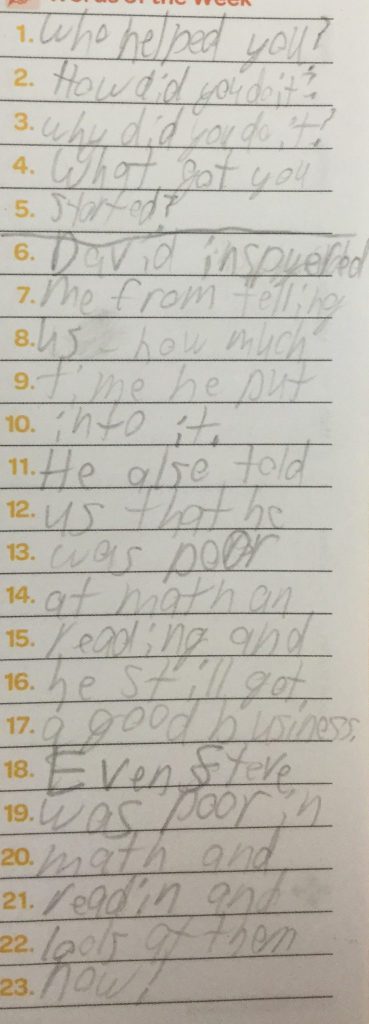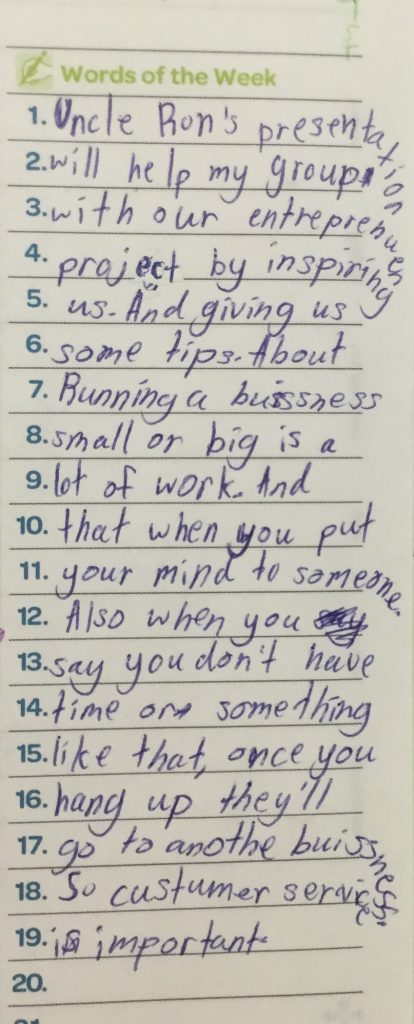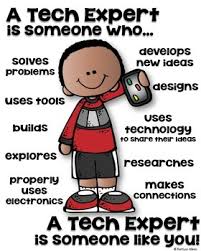Papa ʻehā is blessed by KS ʻohana who are small business owners or know people in our local and global communities who want to share more about their passion and experience. I want to apologize to my 4A ʻohana that I was unable to follow through on my plan for Saturday keiki job shadowing opportunities. Instead I have partnered with Kumu Kanani, our beautiful librarian, to bring more local small business owners to our school. In the first and second trimesters on Wednesdays, I invited several ʻohana members to our classroom to share. In the third trimester, Kumu Kanani and I will feature several more Hilo businesses on Wednesdays in the library.
In February,
Today 4A was invited to an event that featured successful business owner David Fialkow, who invests in small businesses and enjoys working with young entreprenuers. While his talk was addressed to high school students, 4A could relate to his story of entrepreneurship! He highlight several major points:
- An entrepreneur is passionate about what they love to do.
- Entrepreneurs are thoughtful when they pitch their business or product. They are also thoughtful and creative in how they design or redesign their product.
- Entrepreneurs need grit and perseverance because they make lots of mistakes and will struggle a lot. Theyʻve probably struggled in school too, but they never give up!
- Entrepreneurs are bold and believe in themselves because what theyʻre doing might be new and different.
- Entrepreneurs are visionaries and learn to pivot or change when things donʻt always go as plan.
- Entrepreneurs build relationships with people because those relationships could lead to greater things!
Hereʻs what 4A had to say about their visit with David Fialkow and his friend, Steve:




In January, Damonʻs dad (Ron) shared that business can start anywhere! His business started with a dare and a motivation to make something delicious taste even better! We learned about marketing with cost and profit margins. We also learned that sometimes keeping things small and simple is the best way to go.


In December, we had Madisynʻs dad ( Nalu) share his passion retail and graphic designing. We made hats and learned about the placement and colors. From Madisynʻs uncle, (Justin) we learned how to be in competition with ourselves by striving to improve from within!



Did you know in 2015, the state of Hawaii was ranked 12th as the most entrepreneurial state!!!!
This past week, I learned that the entrepreneurial movement in Hawaiʻi is HUGE, and 16% of small businesses are located on the Big Island.
Thanks to Aunty Kanoe P.- Koaliʻs mom, 4A learned these facts and more about entrepreneurs. In addition to sharing about the entrepreneurial movement in Hawaii, Aunty Kanoe is helping 4A connect with local business in Hilo to conduct “job shadowing”. Parents, I will share more about this opportunity soon!

Not only is Aunty Kanoe helping 4A students understand the entrepreneurial movement, she is also helping me! Aunty Kanoe introduced me to Hiplan- Hawaii Island Business Plan Competition: http://hiplan.biz .
Here are a few newspaper articles in the West Hawaii Today about the event:
10/22/17 article:HIplan in high gear- West Hawaii Today
5/19/17 article: Competition offers $25,000 for best business plan | West Hawaii Today
Yesterday, 10/21/17, I attended the Hiplan competition in Kona at Hale ʻIako located on the grounds of the NELHA (Natural Energy Laboratory of Hawaii Authority) to learn more about business plans, proposals, and how entrepreneurs “pitch” their business to a panel of judges. My focus was to learn how I could bring that concept to our “Shark Tank” event in April. Many of the entrepreneurs and UHH business major college students I met were excited to hear that the concept of entrepreneurs was introduced to elementary students.
While the movement of entrepreneurs/small businesses has caught my attention, another eye-opening discovery on the Saturday is the importance of recognizing our ʻike Kūpuna or the intelligence, ingenuity, innovations, skills and talents of Hawaiian people from the past and present. Then teaching 4A students through this project to utilize that ʻike Kūpuna and become ʻŌiwi Edgers or Native Hawaiian Keiki who can use their passion and cultural identity to make a difference in our community!
I will share more about this connection in future blog posts and our student-led conferences in November.

The beauty about our school is that we get to learn from aunties and uncles in our KS ʻohana! Uncle Sonny is one of those highly skilled and talented individuals!
4A students spent Wednesday morning (10/18), exploring and designing their business logo or trademarks with Uncle Sonny P. Students focused on the characteristics of: balance, SIMPLE, 3-syllables, soft colors, and being unique. Uncle Sonny shared ideas of how to include their product and focus on their targeted audience or customers when designing their trademark. An experience that has transformed scribbles into meaningful designs that represents the beauty of each group!

An up and coming ʻOiwi Edger is KSH high school senior Alexia I. She is partnering with 4A to complete her Senior Legacy Project.
Hereʻs a quick letter from Alexia to our 4A ʻOhana: Letter to Parents
 ʻAnoʻai Kākou
ʻAnoʻai Kākou






















